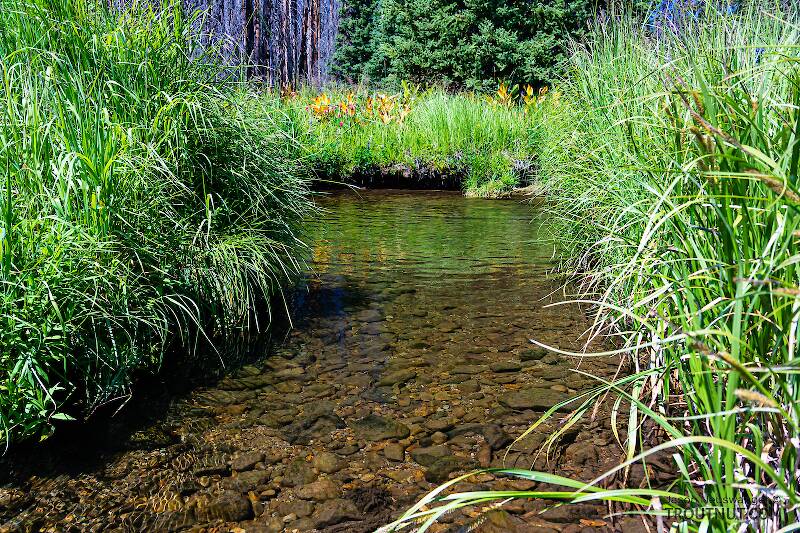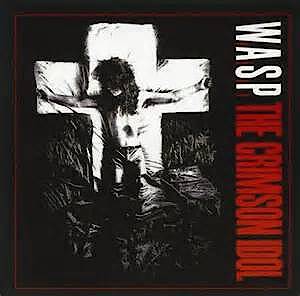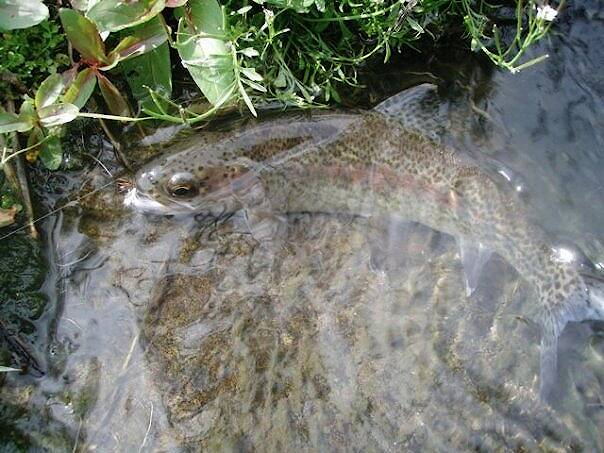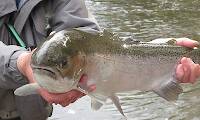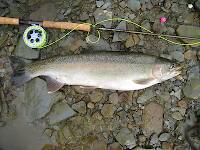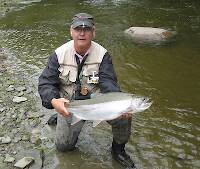
Salmonflies
Pteronarcys californica
The giant Salmonflies of the Western mountains are legendary for their proclivity to elicit consistent dry-fly action and ferocious strikes.
Featured on the forum

It's only barely visible in one of my pictures, but I confirmed under the microscope that this one has a prosternal horn and the antennae are mid-way between the eyes and front of the head capsule.
I'm calling this one Pycnopsyche, but it's a bit perplexing. It seems to key definitively to at least Couplet 8 of the Key to Genera of Limnephilidae Larvae. That narrows it down to three genera, and the case seems wrong for the other two. The case looks right for Pycnopsyche, and it fits one of the key characteristics: "Abdominal sternum II without chloride epithelium and abdominal segment IX with only single seta on each side of dorsal sclerite." However, the characteristic "metanotal sa1 sclerites not fused, although often contiguous" does not seem to fit well. Those sclerites sure look fused to me, although I can make out a thin groove in the touching halves in the anterior half under the microscope. Perhaps this is a regional variation.
The only species of Pycnopsyche documented in Washington state is Pycnopsyche guttifera, and the colors and markings around the head of this specimen seem to match very well a specimen of that species from Massachusetts on Bugguide. So I am placing it in that species for now.
Whatever species this is, I photographed another specimen of seemingly the same species from the same spot a couple months later.
I'm calling this one Pycnopsyche, but it's a bit perplexing. It seems to key definitively to at least Couplet 8 of the Key to Genera of Limnephilidae Larvae. That narrows it down to three genera, and the case seems wrong for the other two. The case looks right for Pycnopsyche, and it fits one of the key characteristics: "Abdominal sternum II without chloride epithelium and abdominal segment IX with only single seta on each side of dorsal sclerite." However, the characteristic "metanotal sa1 sclerites not fused, although often contiguous" does not seem to fit well. Those sclerites sure look fused to me, although I can make out a thin groove in the touching halves in the anterior half under the microscope. Perhaps this is a regional variation.
The only species of Pycnopsyche documented in Washington state is Pycnopsyche guttifera, and the colors and markings around the head of this specimen seem to match very well a specimen of that species from Massachusetts on Bugguide. So I am placing it in that species for now.
Whatever species this is, I photographed another specimen of seemingly the same species from the same spot a couple months later.

Troutnut is a project started in 2003 by salmonid ecologist Jason "Troutnut" Neuswanger to help anglers and
fly tyers unabashedly embrace the entomological side of the sport. Learn more about Troutnut or
support the project for an enhanced experience here.
Ike on Aug 18, 2012August 18th, 2012, 8:10 am EDT
When the bugger should i be using a wooly bugger? I've used them a few times on fishing trips mainly in slower almost slack water pools where my nymphs don't drift enough to be effective, but have had no success. I know these pools have contained fish because most of them I've been able to view from a bridge. mainly I've tried up and across the pool then stripping it in. Ive read a lot about people catching large trout on wooly buggers and streamers and would love to get in on some of that action. Also what size should i be tying my wooly buggers?
Sayfu
Posts: 560
Posts: 560
Sayfu on Aug 18, 2012August 18th, 2012, 8:45 am EDT
UUPS..see them from a bridge, and they often wave back. I've done that so often I can tell by their fin movement that they acknowledge my presence. But buggers can be drifted, stripped, fished in very small sizes to larger sizes. They provide the marabou motion that often triggers a strike. Colors can make a difference. When it is Winter/Spring cold water, and fish lay deep in belly of holes a normal approach is to get then deep, and dead drift them knowing the fishes metabolism is low, and they won't chase their food. My best lake size of buggers is to go small..size #14's and #12's at the biggest on Mustad 9672 3xl hooks. IN rivers?...could be biggies like a 3xl #8, or my smaller ones could be preferred. Usually you can say when fishing one of your river "holes" with a bugger, that a few casts done right is all you need, and move on. If they want the bugger, it will often be on the first pass, maybe the 2nd, or 3rd, but it is time wasted casting a bugger over and over in the same spot. Lots of factors apply...time of day, and the lighting..they may not feed with sun on the water, but water temp., other factors as well.
PaulRoberts on Aug 18, 2012August 18th, 2012, 9:12 am EDT
Lots of options, from imitation to active prospecting -Great fly!
Here's one really good use for them. Pitch them to cover--wood, rock crevices, undercuts--like you're "flippin'" to bass. Pinch a split on the nose so it sinks quickly tight to cover crevices. I used to tie some with a light mono snag-guard too. This can be REALLY effective for some of the largest trout in your streams, esp for browns but I've caught wood oriented 'bows too.
Here's one really good use for them. Pitch them to cover--wood, rock crevices, undercuts--like you're "flippin'" to bass. Pinch a split on the nose so it sinks quickly tight to cover crevices. I used to tie some with a light mono snag-guard too. This can be REALLY effective for some of the largest trout in your streams, esp for browns but I've caught wood oriented 'bows too.
Adirman on Aug 19, 2012August 19th, 2012, 3:23 am EDT
I'm not a big believer in buggers although I have used them on occasion, with some success. I find them most effective dead drifting more nymph-like although I know that alot of guys like to strip them ala streamer style. Earlier this year on the Willow, I watched a guy stripping an olive bugger in slow water, using sorta a moderate retrieve and he was getting hits when nobody else was catching. I was moderately surprised as it was a bright sunny day, about 12 in the afternoon and it seemed to me to be the LAST fly I would have thought to tie on given these conditions!
CaseyP on Aug 19, 2012August 19th, 2012, 5:57 am EDT
some folk are bugger-successful, and others are bugger-challenged. i have never caught a fish on a wooley bugger. nymphs, flymphs, wets, dries, emergers, eggs--you name it, i can make it work.
but never a wooley bugger...
but never a wooley bugger...
"You can observe a lot by watching." Yogi Berra
Ike on Aug 19, 2012August 19th, 2012, 7:32 am EDT
I've heard that term plymphs used a few times now, what exactly is it? id assume some type of a variation of a nymph
Sayfu
Posts: 560
Posts: 560
Sayfu on Aug 19, 2012August 19th, 2012, 8:24 am EDT
Flymph I do think you mean. It is a near surface emerger..soft hackle design with moving hackle. Guy name Hidy termed it a flymph far back...not a nymph, and not an adult fly. Remember this about a lot of flies especially fished subsurface....MOTION is the key. The fly guy often wants to give it a more technical, specific bug induced reaction to feed, but it often just gets down to movement indicating life rather than a twig, bark, or other particulate in the drift. Also something to focus on is how many dead bugs, stillborns, dead egg layers, are drifting mid level in the drift?...lots of them, an virtually all the time during the Summer season especially. I hearken back to my small buggers as often a viable alternative. They can represent dragon flies, stone flies. When I mentioned to the Lake Guru out West here, the guy form Oregon, Denny Ricards, my success in lakes with small buggers, and my thinking they more closely represent insects fish see like dragon fly nymphs, damsels, he says to me, "Do you know why your small wooly buggers work?" " Why I asked?"...Motion he tells me. "They reacted to motion!" Then there came the age of the rubber legged dries!..once only thought to apply to pan fish. Trout went crazy over the rubber legged motion.
Mcjames on Apr 23, 2013April 23rd, 2013, 8:26 am EDT
i like to use woolly buggers after rain/ high water conditions. I figure lots of terrestrial residents like earthworms/salamanders etc get washed down, and crayfish probably get washed down as well
I am haunted by waters
Adirman on Apr 23, 2013April 23rd, 2013, 2:57 pm EDT
Guess I shoulda tied on a bugger this past weekend up in the catskills, what with all the heavy rain we had last Friday!
Gus on Jan 27, 2014January 27th, 2014, 7:58 am EST
I love them for lake trout out here in Southern OR and Northern CA. I usually paly around with the rate of retrieve till I find what works for that lake that time of the year.
"How do you help that son of a bitch?"
"By taking him fishing"
-A River Runs Through It
www.jsrods.com
"By taking him fishing"
-A River Runs Through It
www.jsrods.com
Quick Reply
Related Discussions
Topic
Replies
Last Reply
Five days of warmwater flyfishing in southeastern Michigan - from Jonathon
In Fishing Reports by Jmd123
In Fishing Reports by Jmd123
0
Jul 22, 2009
by Jmd123
by Jmd123
2
Apr 25, 2016
by Afishinado
by Afishinado

